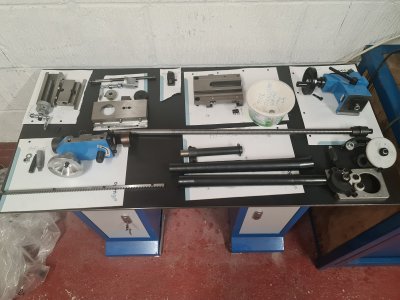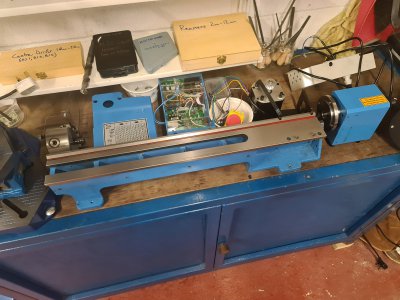- Joined
- Sep 1, 2023
- Messages
- 470
Here's where I am now with my AMA714B (Weiss WBL1835):

and here:

To be fair, the bed is pretty burr free, ways feel nice and smooth, it's surprisingly yellow muck free and there's very little in the way of random paint in places there shouldn't be paint and paint flaking off where it should be solid.
I had heard that Weiss had started putting sealed angular contact bearings in their head stocks, but having checked, these are just plain sealed ball bearings (6206 2RS). So I bought a pair of 7206 2RS from ArcEuroTrade, they'll arrive in a couple of days.
However, there's zero detectable play in the spindle either laterally or front to back.
Anyway, my question is this: I'm wondering if I should bother changing the bearings right now that I have the thing mostly in bits.
Is it going to be worth the effort and terror of hitting one of the parts of my lathe that has to be as precise as possible with my deadblow hammer (albeit with a bit of wood to protect it)?
Or should I wait until I start seeing evidence of wear in the installed bearings?
Or maybe I should reassemble and check the runout at the spindle (yeah, like an eejit I forgot to do it before disassembly), and if it's trouble, get the headstock off and change them then?
What do you'll reckon?
Cheers in advance for any help.
Steve

and here:

To be fair, the bed is pretty burr free, ways feel nice and smooth, it's surprisingly yellow muck free and there's very little in the way of random paint in places there shouldn't be paint and paint flaking off where it should be solid.
I had heard that Weiss had started putting sealed angular contact bearings in their head stocks, but having checked, these are just plain sealed ball bearings (6206 2RS). So I bought a pair of 7206 2RS from ArcEuroTrade, they'll arrive in a couple of days.
However, there's zero detectable play in the spindle either laterally or front to back.
Anyway, my question is this: I'm wondering if I should bother changing the bearings right now that I have the thing mostly in bits.
Is it going to be worth the effort and terror of hitting one of the parts of my lathe that has to be as precise as possible with my deadblow hammer (albeit with a bit of wood to protect it)?
Or should I wait until I start seeing evidence of wear in the installed bearings?
Or maybe I should reassemble and check the runout at the spindle (yeah, like an eejit I forgot to do it before disassembly), and if it's trouble, get the headstock off and change them then?
What do you'll reckon?
Cheers in advance for any help.
Steve

